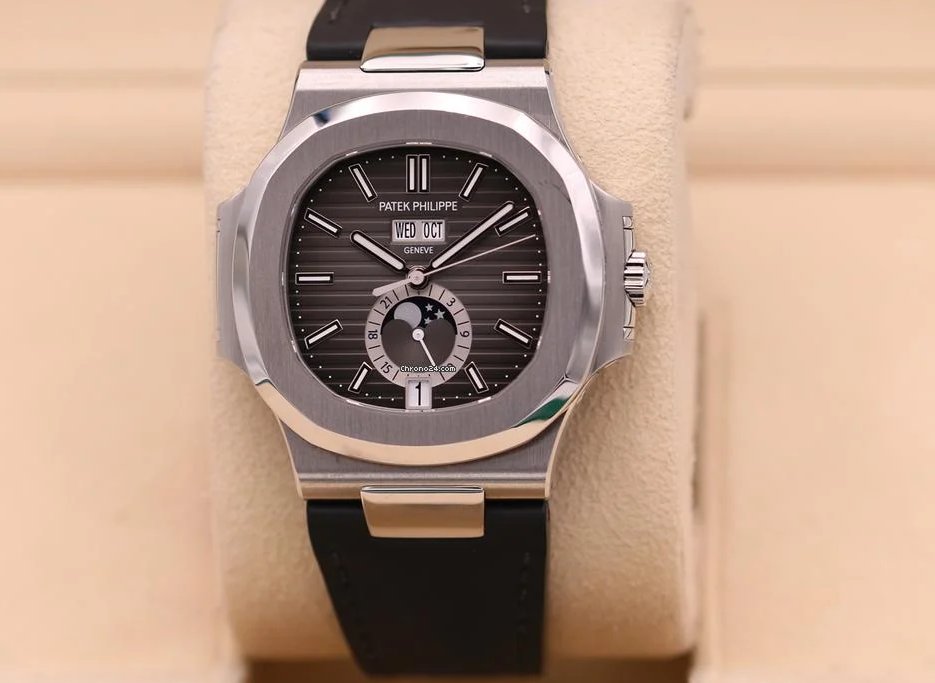Once dismissed as a low-tier niche filled with crude imitations and blatant counterfeits, the replica market has undergone a transformation. From poorly made knock-offs to near-identical “super clones,” today’s replica Patek Philippes are a far cry from their humble beginnings. This article traces the remarkable journey of replica watches, examining how they evolved from unconvincing fakes into sophisticated mimics that challenge even the trained eye.
In the early days of replica watchmaking, authenticity was never on the table. These early replicas were often no more than rough approximations of luxury watches. Basic quartz movements, cheap materials, and visibly flawed designs defined the category. When it came to emulating a brand like Patek Philippe-known for its artisanal dials and intricate complications-these fake luxury watches fell woefully short.
Take, for example, the Calatrava, one of Patek Philippe’s most understated yet elegant models. The original features hand-applied guilloché patterns that dance with the light, each dial a miniature canvas of craftsmanship. Early replicas could barely replicate the layout, let alone the texture. Likewise, the brand’s Grand Complication models-famed for their moonphase indicators and perpetual calendars-presented challenges far beyond the capabilities of clone makers at the time.
For collectors and enthusiasts, these replicas were mere curiosities, lacking the charm and dignity of the real thing. They may have mimicked the silhouette, but they failed to capture the soul of Patek Philippe.
By the early 2000s, however, a noticeable shift was underway. Demand for luxury goods was surging worldwide, and many who admired high-end watches simply couldn’t afford them. This gap between aspiration and accessibility created fertile ground for the replica market to evolve.
Technology played a crucial role. Improvements in CNC machining, material sciences, and supply chain logistics allowed replica manufacturers to elevate their game. Out went the plastic cases and flimsy straps; in came 316L stainless steel, mineral glass, and even rudimentary automatic movements.
Patek Philippe replicas, especially models like the Nautilus and Aquanaut, began to see higher-quality interpretations. These mid-tier replicas were still not perfect-subtle cues like the texture of a bezel or the smoothness of the movement would give them away-but they had undeniably improved. A person wearing one no longer faced immediate scrutiny. The proportions were better, the logos were cleaner, and the overall fit and finish approached something respectable.
This era marked a critical turning point: replicas were no longer just toys or tacky counterfeits. They were becoming tools of illusion-capable of offering a semblance of Patek Philippe’s allure without the astronomical price tag.
Fast forward to 2025, and the replica industry has entered a new golden age. Leading the charge are the so-called “super clones”-replicas so detailed and refined that even seasoned collectors need a magnifying glass and a loupe to tell them apart from the real thing.

These super clones are not built in back-alley workshops. Instead, they are produced in high-tech facilities equipped with precision engineering tools and skilled craftsmen. They use 904L stainless steel-the same high-grade alloy employed by luxury watchmakers-offering superior corrosion resistance and a luxurious sheen. The crystals are now sapphire, scratch-resistant and optically pure.
More impressively, modern Patek Philippe super clones feature custom mechanical movements designed to replicate the visual architecture and performance of Patek’s in-house calibers. Some even mimic the intricate Geneva striping and rotor designs found in the original. Caseback engravings, bracelet finishes, and even weight distribution have been studied and copied to an obsessive degree.
With this new wave, replica watches are no longer just affordable alternatives-they’re engineering marvels in their own right. For a fraction of the cost of a genuine Patek Philippe, enthusiasts can experience the visual pleasure and tactile satisfaction of wearing a watch that looks and feels nearly identical.
The evolution of replica watches is a mirror reflecting broader societal desires-for status, beauty, and the finer things in life. While the early clones were hollow shells, today’s super clones blur the line between authenticity and illusion.
In the case of Patek Philippe, this transformation is especially fascinating. A brand that epitomizes timelessness and heritage has unwittingly inspired a shadow industry just as relentless in its pursuit of perfection. And while nothing can truly replace the value, legacy, and emotion tied to a genuine Patek, the replica market reminds us just how powerful the allure of that Calatrava or Nautilus really is.
Whether admired as technical achievements or criticized as counterfeit curiosities, one thing is certain: replica watches are no longer just fakes. They are reflections of a dream-crafted in steel and sapphire, ticking ever closer to the real thing.

